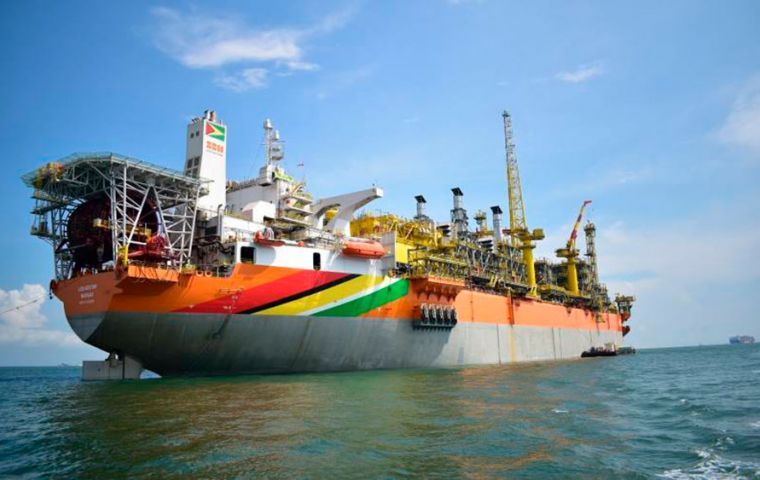MercoPress. South Atlantic News Agency
Guyana expected to deliver 810,000 bpd of light sweet crude by 2025
 Exxon, the operator who owns 45% of the block with Hess holding 30% and CNOOC the remaining 25%, is developing the Stabroek Block at a lightning pace.
Exxon, the operator who owns 45% of the block with Hess holding 30% and CNOOC the remaining 25%, is developing the Stabroek Block at a lightning pace. The former British colony of Guyana, to the north of Brazil and on the Caribbean has emerged as one of the continent’s top oil producers and is poised to become a leading global energy exporter. Since 2015 an Exxon Mobil-led consortium has made a swathe of high-quality oil discoveries in offshore Guyana in the 6.6-million-acre Stabroek Block, with the latest announced in July 2022. It is estimated those finds have uncovered nearly 11 billion barrels of recoverable oil resources in the Stabroek Block with further oil discoveries to come.
Exxon, the operator who owns 45% of the block with Hess holding 30% and CNOOC the remaining 25%, is developing the Stabroek Block at a lightning pace. The Liza oilfield, located in the southeast of the block, is currently pumping around 360,000 barrels of crude oil per day from two floating production storage and offloading (FPSO) vessels; Liza Destiny and Liza Unity. The petroleum pumped from the Liza field is light and sweet, with an API gravity of 32 degrees and 0.58% sulfur content. That makes it easier and cheaper to extract as well as refine. This means Liza-grade crude oil is cheaper and easier to produce as well as refine into high-quality fuels, giving it a lower carbon footprint compared to heavier sourer grades, particularly those produced in neighboring Venezuela.
As a result, the oil discovered and produced in offshore Guyana is particularly attractive to global energy companies, which are under considerable pressure to significantly reduce emissions and decarbonize their operations. Industry low costs, as reflected by offshore Guyana’s forecast average breakeven price of US$35 per barrel, make the deeply impoverished country one of the lowest cost and hence most profitable jurisdictions in Latin America. These factors have seen offshore Guyana emerge as what industry insiders are calling the world’s most exciting oil frontier. That is driving even greater investment inflows into Guyana’s hydrocarbon sector from foreign energy companies.
In November 2020, at a time when Brent was selling for around US$ 45 per barrel, Exxon announced it was prioritizing Guyana, along with the Permian Basin and Brazil, for capital spending because of the jurisdiction’s considerable potential. Exxon’s ongoing exploitation of the Stabroek Block will play a vital role in the company’s plans to aggressively decarbonize its operations after being heavily criticized for ignoring the perils of climate change. In 2021, Exxon announced that it intended to reduce greenhouse gas emissions from its upstream operations by between 40% and 50% by 2030, which will in part occur because of its commitment to end flaring.
These reasons see Exxon pressing ahead with developing the Stabroek Block and exploration activities in other blocks where it holds a stake in offshore Guyana. During 2021 the energy super-major announced it intends to spend US$ 20 billion to US$ 25 billion on capital expenditures between 2022 and 2027, with 60% of that investment directed to Guyana, Brazil, the Permian and its LNG as well as chemical businesses. The 220,000 barrel per day Payara project is currently under development with it approximately five months ahead of schedule and slated to commence production before the end of 2023. Exxon is also advancing the Yellowtail project, which is forecast to come online during 2025 with a capacity of 250,000 barrels per day. The completion of Payara and Yellowtail will see Stabroek Block producing at least 810,000 barrels per day by the end of 2025, potentially even more.
Industry analysts estimate that Guyana will be pumping at least one million barrels of crude oil daily by 2027, while some believe that figure could be higher, reaching 1.2 million barrels. When that occurs, Guyana will overtake Colombia to become the third largest oil producer in Latin America and the Caribbean. Recent discoveries in the basin, along with estimates of their hydrocarbon potential, point to the combined recoverable oil resources of offshore Guyana and Suriname being more than 18 billion barrels of oil equivalent. That number is significantly higher than the mean 13.6 billion barrels of undiscovered oil resources estimated by the U.S. Geological Survey in 2012.




Top Comments
Disclaimer & comment rulesCommenting for this story is now closed.
If you have a Facebook account, become a fan and comment on our Facebook Page!